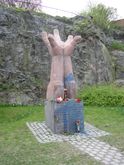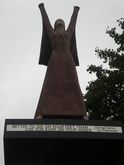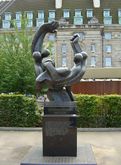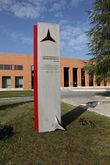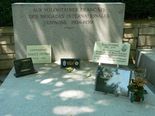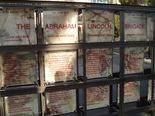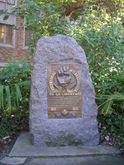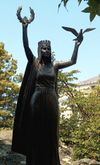الألوية الأممية
الألوية الأممية (إسپانية: Brigadas Internacionales؛ إنگليزية: International Brigades)، كانت وحدات عسكرية شكلها متطوعين من بلدان مختلفة، سافروا إلى إسپانيا للقتال من أجل الجمهورية الإسپانية الثانية أثناء الحرب الأهلية الإسپانية بين عام 1936 و1939.
قُدر عدد المتطوعين المقاتلين فيما بين 32.000-35.555 فرد، على الرغم من أنه لم يكن هناك ما يزيد عن 20.000 فرد نشط في نفس الوقت.[1] ربما شارك 10.000 شخص إضافيين في مهام غير قتالية وحوالي 3.000-5.000 أجنبي كانوا أعضاء في الكونفدرالية الوطنية للعمل.[1] أتى المتوطعون من "53 بلد" للقتال ضد القوات الكتائب الإسپانية بقيادة الجنرال فرانشيسكو فرانكو الذي كان يتلقى مساعدات من القوات الألمانية والإيطالية.[2]
. . . . . . . . . . . . . . . . . . . . . . . . . . . . . . . . . . . . . . . . . . . . . . . . . . . . . . . . . . . . . . . . . . . . . . . . . . . . . . . . . . . . . . . . . . . . . . . . . . . . . . . . . . . . . . . . . . . . . . . . . . . . . . . . . . . . . . . . . . . . . . . . . . . . . . . . . . . . . . . . . . . . . . . .
التشكيل والتجنيد
Using foreign Communist Parties to recruit volunteers for Spain was first proposed in the Soviet Union in September 1936—apparently at the suggestion of Maurice Thorez[3]—by Willi Münzenberg, chief of Comintern propaganda for Western Europe. As a security measure, non-Communist volunteers would first be interviewed by an NKVD agent.
By the end of September, the Italian and French Communist Parties had decided to set up a column. Luigi Longo, ex-leader of the Italian Communist Youth, was charged to make the necessary arrangements with the Spanish government. The Soviet Ministry of Defense also helped, since they had experience of dealing with corps of international volunteers during the Russian Civil War. The idea was initially opposed by Largo Caballero, but after the first setbacks of the war, he changed his mind, and finally agreed to the operation on 22 October. However, the Soviet Union did not withdraw from the Non-Intervention Committee, probably to avoid diplomatic conflict with France and the United Kingdom.
The main recruitment centre was in Paris, under the supervision of Soviet colonel Karol "Walter" Świerczewski. On 17 October 1936, an open letter by Joseph Stalin to José Díaz was published in Mundo Obrero, arguing that victory for the Spanish second republic was a matter not only for Spaniards, but also for the whole of "progressive humanity"; in a matter of days, support organisations for the Spanish Republic were founded in most countries, all more or less controlled by the Comintern.[بحاجة لمصدر]
Entry to Spain was arranged for volunteers: for instance, a Yugoslav (ethnic Croat), Josip Broz, who would become famous as Marshal Josip Broz Tito, was in Paris to provide assistance, money and passports for volunteers from Eastern Europe. Volunteers were sent by train or ship from France to Spain, and sent to the base at Albacete. However, many of them also went by themselves to Spain. The volunteers were under no contract, nor defined engagement period, which would later prove a problem.
Also many Italians, Germans, and people from other countries joined the movement, with the idea that combat in Spain was a first step to restore democracy or advance a revolutionary cause in their own country. There were also many unemployed workers (especially from France), and adventurers. Finally, some 500 communists who had been exiled to Russia were sent to Spain (among them, experienced military leaders from the First World War like "Kléber" Stern, "Gomez" Zaisser, "Lukacs" Zalka and "Gal" Galicz, who would prove invaluable in combat).
The operation was met by communists with enthusiasm, but by anarchists with skepticism, at best[بحاجة لمصدر]. At first, the anarchists who controlled the borders with France were told to refuse communist volunteers, and reluctantly allowed their passage after protests[بحاجة لمصدر]. A group of 500 volunteers (mainly French, with a few exiled Poles and Germans) arrived in Albacete on 14 October 1936. They were met by international volunteers who had already been fighting in Spain: Germans from the Thälmann Battalion, Italians from Centuria Gastone Sozzi and French from Commune de Paris Battalion. Among them was British poet John Cornford. Men were sorted according to their experience and origin, and dispatched to units.
وسرعان ما أصبحت بلدة البسيط المقر الرئيسي للألوية الأممية ومستودعها الرئيسي. وكانت الألوية تدار بواسطة ثلاثي ترويكا من أعلام الكومنترن: أندريه مارتي كان القائد؛ لويجي لونگو (گالّو) كان المفتش العام؛ وجوزپى دي ڤيتوريو (نيكولِتـِّي) كان القوميسار السياسي الأكبر.[4]
قام الحزب الشيوعي الفرنسي بإمداد الزي العسكري للألوية. وقد تم تنظيمهم في ألوية مختلطة، الوحدة العسكرية الأساسية من الجيش الشعبي الجمهوري.[5] Discipline was extreme. For several weeks, the Brigades were locked in their base while their strict military training was under way.
الخدمة
المواجهات الأولى: حصار مدريد
معركة خاراما
معركة گوادالاخارا

فض الألوية

التشكيل
نظرة عامة
الكتائب غير الإسپانية
الألوية حسب البلد
العلم الجنسية التقديرات هوامش 
فرنسا 8,962[6]–9,000[2][7] 
إيطاليا 3,000[6][7]–3,350[8]  /
/
ألمانيا/النمسا 3,000[2]–5,000[7] Beevor quotes 2,217 Germans and 872 Austrians.[6] 
پولندا 3,000[2][7]–3,113[6] 
الولايات المتحدة 2,341[6]–2,800[7][8] دول البلقان 2,095[6] 
الاتحاد السوڤيتي 2,000-3,000[2] Though "never more than 800 present at any one time".[9] 
المملكة المتحدة 1,800,[7] 2,000,[8] c. 4,000.[10] Beevor quotes 1,843 "of whom 549 were Scots".[6] BBC quotes "about 4,000" based on MI5 estimates, released by the PRO, Kew.[10] 
بلجيكا 1,600[7]–1,722[6] 
كندا 1,546–2,000[7] Thomas estimates 1,000.[8] 
يوغسلاڤيا 1,500[2]–1,660[7] انظر Yugoslav volunteers in the Spanish Civil War. 
كوبا 1,101[11][12] 
تشيكوسلوڤاكيا 1,006[6]–1,500[2][7] دول البلطيق 892[6] 
الأرجنتين 740[13] 
هولندا 628[6] 
الدنمارك 550 220 قتلى. 
إسكتلندا 549 Scots from both Lowlands and Highlands, split between the British Battalion, Abraham Lincoln Battalion and Canadians.[6] 
المجر 528[6]–1,500[2] 
السويد 500[14] An estimated 799[6]–1,000[8] people from Scandinavia (Thomas estimates about 1,000 – of whom 500 were Swedes.[14]) 
بلغاريا 462 
سويسرا 408[6]–800[15] 
أيرلندا 250 Split between the British Battalion and the Abraham Lincoln Battalion which included the famous Connolly Column 
النرويج 225 100 died.[16][17][18] 
فنلندا 225 Including 78 Finnish Americans and 73 Finnish Canadians, ca. 70 died.[19] 
إستونيا 200[20] 
اليونان 160[بحاجة لمصدر] 
الپرتغال 134[6] 
لوكسمبورگ 103 Livre historiographic d'Henri Wehenkel: D'Spueniekämfer (1997) 
الصين 100[21] Organised by the Chinese Communist Party, members were mostly overseas Chinese. Their leader was Xie Weijin.[22] 
المكسيك 90 
قبرص 60[بحاجة لمصدر] 
الفلپين 50 [23][24] 
ألبانيا 25 
كوستاريكا 24[2] أخرى 1,122[6]
. . . . . . . . . . . . . . . . . . . . . . . . . . . . . . . . . . . . . . . . . . . . . . . . . . . . . . . . . . . . . . . . . . . . . . . . . . . . . . . . . . . . . . . . . . . . . . . . . . . . . . . . . . . . . . . . . . . . . . . . . . . . . . . . . . . . . . . . . . . . . . . . . . . . . . . . . . . . . . . . . . . . . . . .
الوضع بعد الحرب
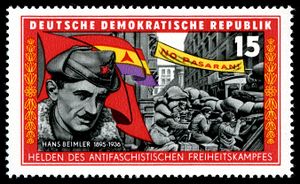
ألمانيا الشرقية
كندا
سويسرا
المملكة المتحدة
الولايات المتحدة
التقدير
إسپانيا
فرنسا
النصب التذكارية
- ]] Dudelange
الرمزية
مشاهير الألوية الأممية
|
. . . . . . . . . . . . . . . . . . . . . . . . . . . . . . . . . . . . . . . . . . . . . . . . . . . . . . . . . . . . . . . . . . . . . . . . . . . . . . . . . . . . . . . . . . . . . . . . . . . . . . . . . . . . . . . . . . . . . . . . . . . . . . . . . . . . . . . . . . . . . . . . . . . . . . . . . . . . . . . . . . . . . . . .
انظر أيضاً
- التدخل الإسپاني في الحرب الأهلية الإسپانية
- الصندوق التذكاري للألوية الأممية
- المناهضة المسلحة للفاشية
- المتطوعون الاشتراكيون الأيرلنديون في الحرب الأهلية الإسپانية
- أرديتي دل پوپولو
- المتطوعون الأجانب الوطنيون
- ذهب موسكو
- الإرهاب الأحمر (إسپانيا)
المصادر
- ^ أ ب Thomas (2003), pp. 941–5; Beevor (2006), p. 257.
- ^ أ ب ت ث ج ح خ د ذ Thomas (2003), pp. 941–5
- ^ Beevor 1982, p. 124
- ^ Thomas 2003, p. 443
- ^ Orden, circular, creando un Comisariado general de Guerra con la misión que se indica (PDF). Vol. Año CCLXXV Tomo IV, Núm. 290. Gaceta de Madrid: diario oficial de la República. 16 October 1936. p. 355.
- ^ أ ب ت ث ج ح خ د ذ ر ز س ش ص ض ط ظ Lefebvre (2003), p. 16. Quoted by Beevor (2006), p. 468.
- ^ أ ب ت ث ج ح خ د ذ ر Quoted in Alvarez (1996).
- ^ أ ب ت ث ج Thomas (1961), pp. 634–639.
- ^ Beevor (2006), p. 163.
- ^ أ ب BBC News (2011).
- ^ http://www.albavolunteer.org/2012/07/los-voluntarios-cubanos-en-la-guerra-de-espana/
- ^ http://www.albavolunteer.org/2011/08/new-book-on-cubans-in-scw/
- ^ http://www.albavolunteer.org/2010/06/voluntarios-argentinos-en-la-brigada-xv-abraham-lincoln/
- ^ أ ب Thomas (2003), p. 943.
- ^ خطأ استشهاد: وسم
<ref>غير صحيح؛ لا نص تم توفيره للمراجع المسماةSwissinfo_2008 - ^ Moen, Jo Stein og Sæther, Rolf: Tusen dager – Norge og den spanske borgerkrigen 1936-1939, Gyldendal 2009, ISBN 978-82-05-39351-6
- ^ [1]
- ^ [2]
- ^ Juusela, Jyrki: Suomalaiset Espanjan sisällissodassa, Atena Kustannus 2003, ISBN 951-796-324-6
- ^ Kuuli, (1965).
- ^ China Museum (May 31, 2012). "朱德等赠给国际纵队中国支队的锦旗". chnmuseum.
- ^ Unknown (March 30, 2005). "战斗在西班牙反法西斯前线的中国支队". Luobinghui.
- ^ http://pinoyhistory.proboards.com/thread/1673
- ^ http://www.florentinorodao.com/scholarly/sch95b.htm
- ^ Thomas (2003), p. 927.
- ^ Thomas (2003), p. 926.
المراجع
- Alvarez, Santiago. (بالإسپانية) Historia politica y militar de las brigadas internacionales Madrid: Compañía Literaria, 1996.
- Anderson, James W. The Spanish Civil War: A History and Reference Guide. Santa Barbara: Greenwood Press, 2003. ISBN 978-0-313-32274-7
- Beevor, Antony. [1982] The Spanish Civil War. Reissued London: Weidenfeld & Nicolson (Cassell), 1999. ISBN 978-0-304-35281-4
- Beevor, Antony. (2006). The Battle for Spain: The Spanish Civil War 1936–1939. London: Weidenfeld & Nicolson, 2006. ISBN 978-0-297-84832-5
- Bradley, Ken International Brigades in Spain 1936-39 with Mike Chappell (Illustrator) Published by Elite. ISBN 978-1855323674. Good basic introduction to the subject in a readable and well-illustrated format. Author made several visits to battlefields and interviewed veterans in the 1980s and 90’s.
- Castells, Andreu. (بالإسپانية) Las brigadas internacionales en la guerra de España. Barcelona: Editorial Ariel, 1974.
- Copeman, Fred (1948). Reason in Revolt. London: Blandford Press, 1948.
- Eby, Cecil. Comrades and Commissars. Pennsylvania: Penn State University Press, 2007. ISBN 978-0-271-02910-8
- Gurney, Jason (1974) Crusade in Spain. London: Faber, 1974. ISBN 978-0-571-10310-2
- Kantorowicz, Alfred (1938, 1948), Spanisches Tagebuch, Madrid (1938), Berlin (1948).
- Kuuli, O; Riis, V; Utt, O; (editors) (1965) قالب:Et icon Hispaania tules. Mälestusi ja dokumente fašismivastasest võitlusest Hispaanias 1936.-1939. aastal. Tallinn: Eesti raamat.
- Lefebvre, Michel; Skoutelsky, Rémi. (بالإسپانية) Las brigadas internacionales. Barcelona: Lunwerg Editores (2003). ISBN 84-7782-000-7
- Orwell, George. [1938] A Homage to Catalonia. London: Penguin Books, 1969. (New edition) ISBN 978-0-14-001699-4
- Thomas, Hugh. (1961) The Spanish Civil War. London: Eyre & Spottiswoode, 1961.
- Thomas, Hugh. (2003) The Spanish Civil War, 2003. London: Penguin (Revised 4th edition), 2003. ISBN 978-0-14-101161-5
- Wainwright, John, L. (2011) The Last to Fall: the Life and Letters of Ivor Hickman - an International Brigader in Spain. Southampton: Hatchet Green Publishing. ISBN 978-0-9568372-1-9
- "Spanish Civil War 'drew 4,000 Britons' to fight fascism". London: BBC News. 27 June 2011. Retrieved 28 June 2011.
وصلات خارجية
- IBMT the international brigade memorial trust
- Abraham Lincoln Brigade Archives
- Reproduction of International Brigades flags, badges and t-shirts
- Freedom fighters or Comintern army? The International Brigades in Spain by Andy Durgan
- International Solidarity With the Spanish Republic: 1936–1939
- Documents on the International Brigades from "Trabajadores: The Spanish Civil War through the eyes of organised labour", a digitised collection of more than 13,000 pages of documents from the archives of the British Trades Union Congress held in the Modern Records Centre, University of Warwick
- إعلام
- Articles containing إسپانية-language text
- Pages using Lang-xx templates
- Articles containing إنگليزية-language text
- Articles with unsourced statements from December 2009
- Articles with unsourced statements from July 2013
- Articles with hatnote templates targeting a nonexistent page
- Articles with unsourced statements from May 2011
- الألوية الأممية
- المتطوعون الأجانب في الأهلية الإسپانية
- القوات المسلحة للجمهورية الإسپانية الثانية
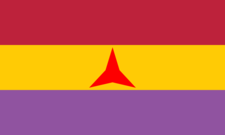
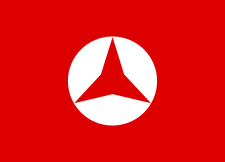
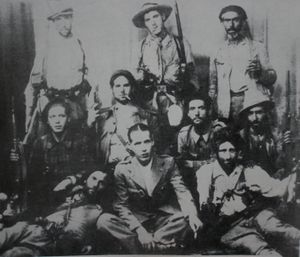
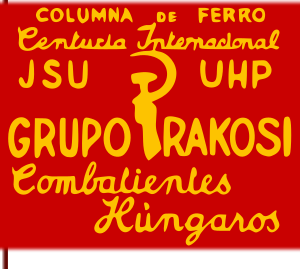

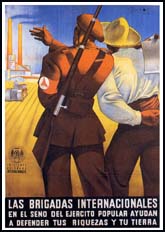
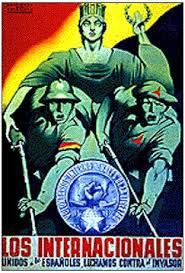

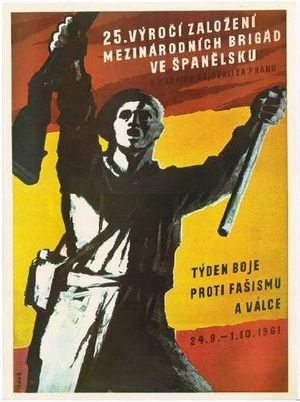

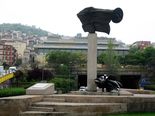
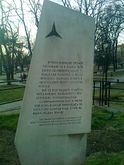
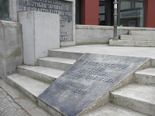
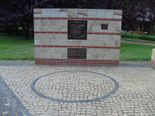
![]] Dudelange](/w/images/thumb/1/16/Dudelange_No_pasaran_Wercollier_01.jpg/100px-Dudelange_No_pasaran_Wercollier_01.jpg)
